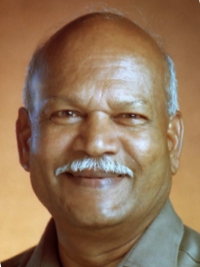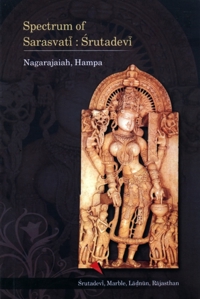|
[55] Natya Sarasvatī, Haḷebīḍu Museum, 12th cent. |
The displaced three four-armed dancing images of Sarasvatī, now in the Museum of Haḷebīḍu (Hassan Dt.), the two sculptures of nāṭya Sarasvatī on the outer wall of excellent Hoysaḷeśvara temple (Haḷebīḍu), and Hosahoḷalu (Mandya Dt.) temple, are all matchless images in the entire hoard of extant images of Sarasvatī. Haḷebīḍu (s.a. Dvārasamudra) once thrived as the capital of the Hoysaļa Kingdom.
 The smiling round-faced Sarasvatī holds a palm-leaf manuscript in her lower left arm and it is in accordance with iconographic prescription. The three layers of palm-leaves placed one above the other is distinctly visible. Deity wears a highly embellished conical crown. The big sized ear-rings dangling from the earlobe, beads of rosary, armlet, anklet, necklace, waist band, stana-hāra, 'breast ornament', and kaṭi-hāra, 'waist ornament', and bangles -are attractive. Though front portion of the round shaped face is a bit mutilated, its beauty has not diminished. The rosary held in her stretched lower right palm looks as though freely swinging because of the attractive dancing gesture.
The smiling round-faced Sarasvatī holds a palm-leaf manuscript in her lower left arm and it is in accordance with iconographic prescription. The three layers of palm-leaves placed one above the other is distinctly visible. Deity wears a highly embellished conical crown. The big sized ear-rings dangling from the earlobe, beads of rosary, armlet, anklet, necklace, waist band, stana-hāra, 'breast ornament', and kaṭi-hāra, 'waist ornament', and bangles -are attractive. Though front portion of the round shaped face is a bit mutilated, its beauty has not diminished. The rosary held in her stretched lower right palm looks as though freely swinging because of the attractive dancing gesture.Except for the far bigger sized goad and noose, held in her upper hands, which does not go well with the symmetry, the whole frame is vigorous and full of life. The graceful movement of the classical dance and equally graceful bend in the right leg with the prominently thrust out left leg to her right, depicted in the sculpture confirms that Sarasvatī alias Śrutadevī is indeed goddess of knowledge, art and music. The two action oriented male musicians in the flank are beating the drums and their big sized coiffure draws our attention. Their knees are bent to give support to the drum.
The iconographic details are unusual in holding symbols of pāśa 'noose', and aṅkuśa,'goad', in two of the upper arms. It is not in line with approved norms, though the two lower arms holding pustaka, 'book', and japamaṇi or akṣamālā, 'rosary', is in accordance with the description of the deity. This peculiar combination of benific and malefic iconographic aspects featuring in these rare images needs a detailed iconographic description and discussion.
 Prof. Dr. Nagarajaiah Hampana
Prof. Dr. Nagarajaiah Hampana

